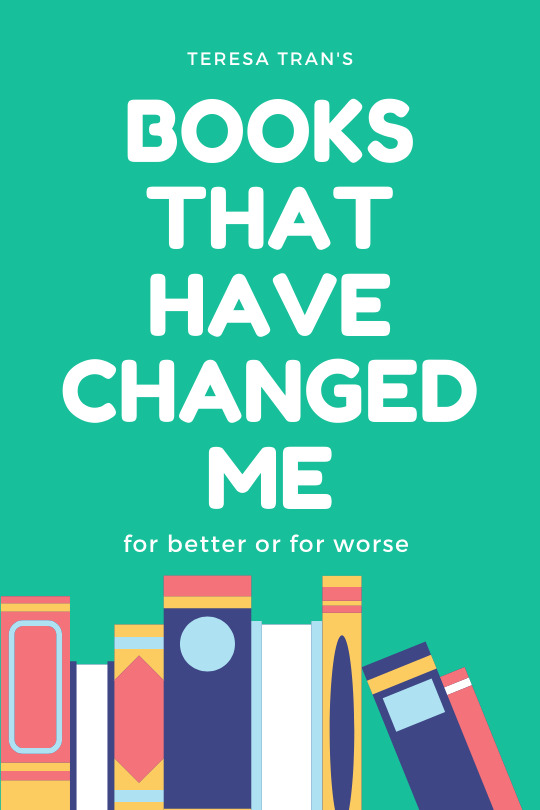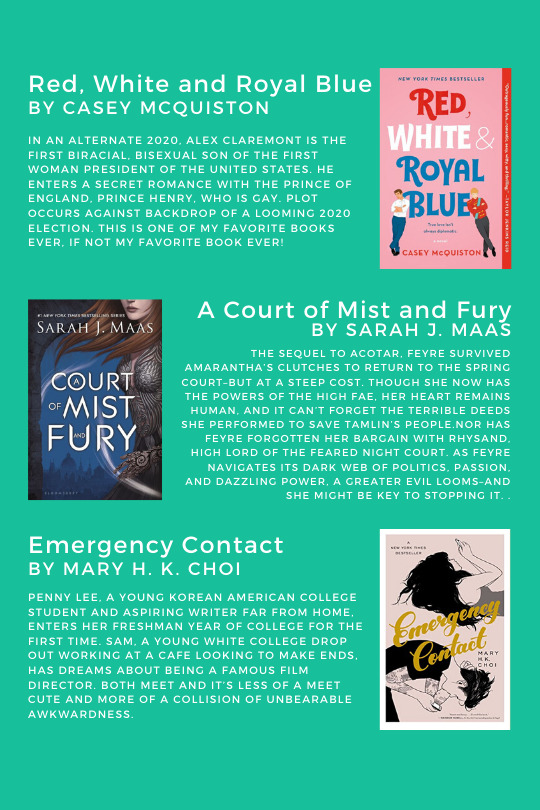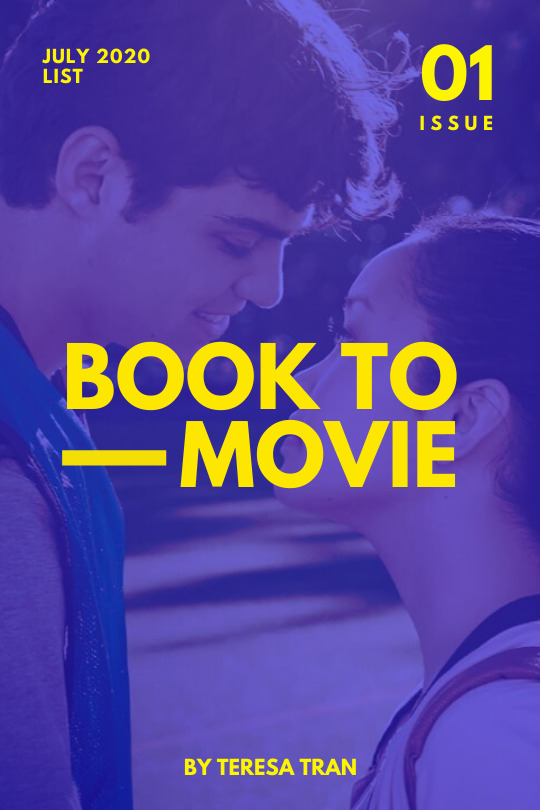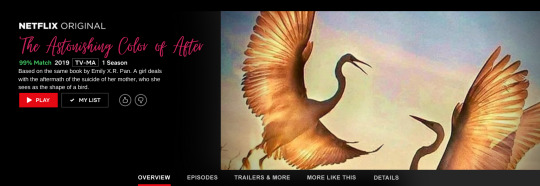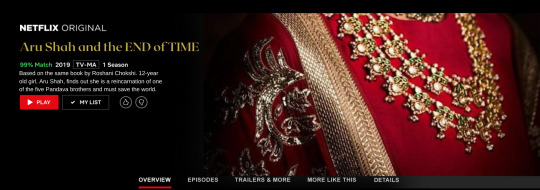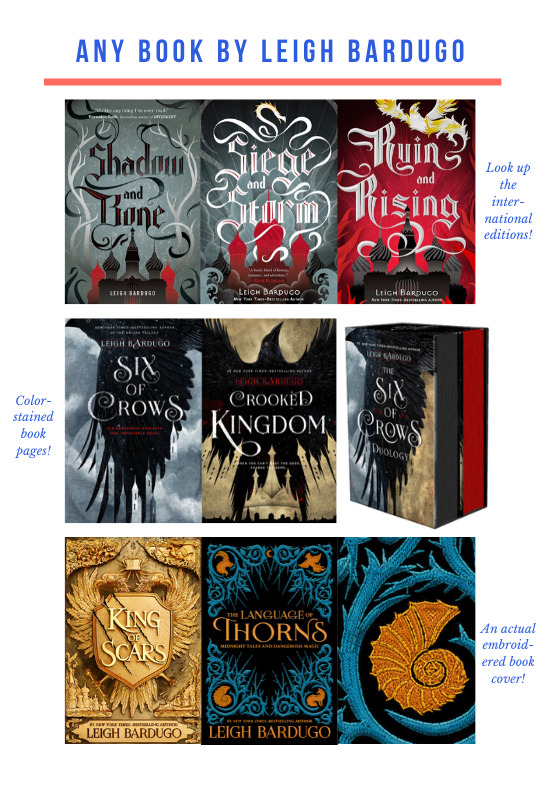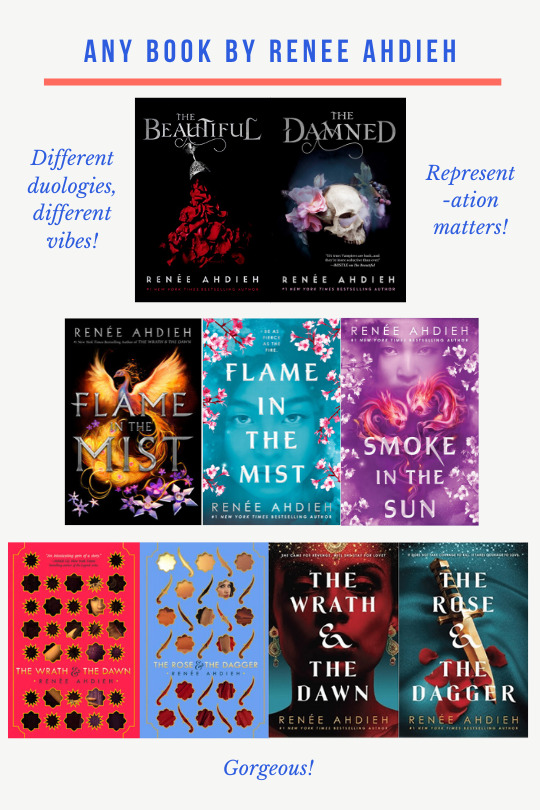#YAL SU20
Text
Dear Blog,
Prompt: Historical fiction can be a tough sell for student readers as it typically is blurry about the lines between what is history and what is fiction - but also because the periods covered aren't in any kind of alignment with what they know in terms of history. Take a look at this timeline of YA Historical Lit: http://www.epicreads.com/blog/the-age-of-ya-a-timeline-of-historical-fiction/. What patterns do you notice? What role will/should/can this genre play in your teaching and classroom library? How do we make this genre intoxicating to young readers? (Or, should it be?)
I agree that historical fiction can be a tough sell for student readers. I know that for me, I didn’t grow up reading a lot of historical fiction novels. If anything, I remember devouring picture books about Greek and Egyptian mythology, checking out nonfiction texts about the Titanic sinking and Ancient Rome, and obsessing over American Girls stories that featured a girl from a different historical era. But even before high school, I never really read a historical fiction novel where it showcased, say, an alternative take on a historical period, or perspectives from people who were erased from a specific time in history, or a fictional narrative based on true historical events. Historical fiction simply wasn’t marketed towards me -- or showed up often in the curriculum for me to have to read it. It wasn’t until I got into high school when I started to read fictional stories of YA characters in historical time periods, particularly during colonial American slavery and the 1920s, that I started to really awaken to this genre and enjoy it. Based on the timeline of YA Historical Lit from Epic Reads, I noticed that most of the books on the list were written by women. YA is dominated by women in general, so that’s not a surprise. However, I went even further as to randomly look up a name from each era on the list -- and I found that all of the authors I searched up were white women. Of course, there are some authors of color on the list and some men on the list too, but now I’m curious as to why white women authors are overrepresented in the YA historical fiction genre? Is this part of the reason why some students, particularly students of color who descend from families and marginalized groups who tend to be left out of historical narratives, can’t relate to YA historical fiction and thus, is a tough sell? I think more research should be done to answer this question. Perhaps a case study?
Regardless, I still think YA historical fiction is an amazing genre, has qualities that are important to introduce to young readers, and contains aspects of which young readers will enjoy. To be honest, I perceive YA historical fiction playing a pretty big role in my teaching and classroom library. As a future English/Language Arts educator, I firmly believe English and History are intertwined with each other. You can’t teach one without the other. With every story or text you read and unpack, there is always a historical context (even if it’s fictional). What’s the historical context of when a story is written? How does the historical context affect the politics and structure of the story? How does the era from which the author is from affect how they perceive the world -- and thus their story? The current politics and story conventions we understand and accept now aren’t the same as the ones understood and accepted many generations ago. As time passes, our perception of history -- and certain stories change. It’s important to examine all of these questions and truths so that we can learn from history, so that we can learn from the fictional narratives written for an author’s time period and target audience, and so that we can create better history and better stories. In particular, I want to include historical fiction novels from perspectives and about eras that aren’t U.S/Global North/western centric. Another pattern I noticed from the list was that many of the books were situated in historical American or European historical contexts. If there’s one thing I want to teach in my classroom, it’s the truth that the U.S., the Global North, and the West are not the center of the world. English is the colonizer’s language. While I live in the U.S. and I speak English, I want to use historical fiction novels as a tool to teach that there are thousands of other cultures and hundreds of other countries whose history does not get told worldwide because of American and Western imperialism and colonialism. What’s the point of historical fiction novels if not to tell the TRUTH, as you see it? From what I see, I know the white American/Western cis straight man is not the default of history and of literature. I know that history is not filled with only American/Western cis, straight stories. And I know that the future will not be dominated by only American/Western cis, straight stories. At least, not if I can help it. :)
0 notes
Text
Reading Ladders - Romance
Prompt: Following the ideas in the Lesesne readings, create a book ladder that takes readers from YA books to more complex texts. Share a rationale in your post that helps us see how your ladder works - and provides thinking on how the complexity of the texts scaffolds from one to the other. You also will want to identify the grade level and reading level of the reader you've built this ladder to engage... Post this to your blog (which means you can also be as visual as you'd like.)
Based on the Lesesne readings and other folks’ reading ladders, it seems the one genre or area that people haven’t touched or made a ladder for is...romance! (The best genre of them all (; ). When I think about romance, I think about how it shows up in practically all genres and stories, whether we intend for it to or not. Love unites us all, right? Love for other folks is what makes us human, right? And being human means we’re drawn to stories and storytelling about the various kinds of love we partake in and spread and practice.
My reading ladder will be start off focused on romance as a plot element that appears in different genres, such as fantasy/sci-fi or contemporary, and then steadily lead to the actual young adult/adult romance genre. I’m constructing my ladder in such a way because while romance as a separate individual genre exists more so for adults, there is definitely a growing romance category within young adult literature these days, and I want to recognize that reality, while also hoping this ladder will show the wild breadth of romance that appears across different genres that are slightly more established in the young adult age category.
Grade Level: 6th - 12th // Reading Level: 5th - 8th
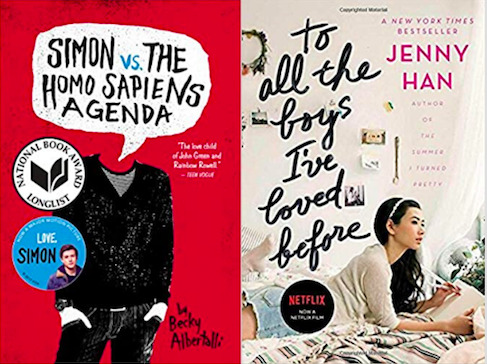
Bottom/1st Step - Simon vs. The Homo Sapiens by Becky Albertalli - Contemporary
Simon Spier, a closeted gay boy living in Atlanta, GA, strikes up an online correspondence with a mystery queer boy, Blue. Contemporary genre. It’s a fun, quick, and relatable read. It offers a diverse perspective of a gay kid trying to find love for himself that many young queer kids can relate to. It’s a good starting point for young kids who want to read books about a young boy coming into his own through the lens of sexuality and romance -- and also for kids who aren’t totally into romance for the romance element in Simon is only 1/3...maybe even 1/4 of the plot.
2nd Step - To All The Boys I’ve Loved Before by Jenny Han - Contemporary
Lara Jean Song, a Korean American girl writes five secret love letters to five different boys. One day, the letters are sent out. Her life is then turned upside down as she enters a fake-dating relationship scenario with the popular boy named Peter Kavinsky...where she ends up falling for him! Also contemporary genre. It’s a perfect follow-up to Simon because (1) it also has a book to movie adaptation, (2) it also contains a coming-of-age narrative, but this time with a Korean American girl protagonist and (3) it contains romance, but the romance doesn’t overtake the entire book. TATBILB offers a different, fresh diverse perspective on a person experiencing young love for the first time, but is easily on the same reading level and similar writing style as Simon, so it’s perfect for kids who want something close to Simon, but a little bit different in experience.
Grade Level: 9th - 12th // Reading Level: 9th - 12th
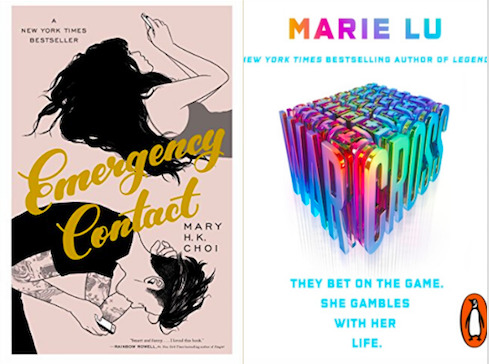
3rd Step - Emergency Contact by Mary H. K. Choi - Contemporary
Penny Lee, a young Korean American college student and aspiring writer far from home, enters her freshman year of college for the first time. Sam, a young white college drop out working at a cafe looking to make ends, has dreams about being a famous film director. Both meet and it’s less of a meet cute and more of a collision of unbearable awkwardness. Also contemporary genre. This book naturally builds off of Simon and TATBILB with its romance acting more as a subplot and as a vehicle for individual character growth, but instead it takes place in college. The book also contains one Asian American girl protagonist and a white guy protagonist, as well as contain a meet cute and conversations over text, so it’s a nearly perfect combination of Simon and TATBILB. This book is perfect for readers who want a peek at college life and a slightly more complex text with a different sense of humor from the previous two books, but still experience the emotional ups and downs of young people finding themselves through their passions and the people/partners they meet that we often see in contemporary romance books with younger characters.
4th Step - Warcross by Marie Lu - Sci Fi Thriller
While I haven’t read this book yet, I’ve heard so many good reviews about it that I had to include it on the list! Emika Chen, a Japanese hacker and bounty hunter, is whisked off to Tokyo and thrust into a world of fame and fortune as a hired spy in the Warcross game. But soon her investigation into the game uncovers a sinister plot, with major consequences for the entire Warcross empire. Sci Fi thriller. This book has a slightly more mature romance arc compared to the previous books, but it’s still age appropriate for high schoolers. It offers a different genre for readers who want to read some romance, but want a sci-fi twist to it. It also is written by an Asian American author and stars Japanese characters, so it’s a perfect next book to read after reading a couple of books that star Asian American characters entering romances in a different genre.
Grade Level: 10th - 12th // Reading Level: 10th - 12th
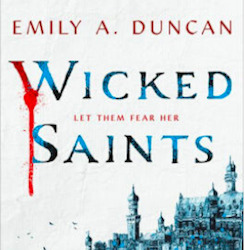
5th Step - Wicked Saints by Emily A. Duncan - Gothic Fantasy
This book is a bit of a departure in the romance ladder. It’s about Nadya Lapteva, a young orphan who can talk to the Slavic gods and has powers granted to her through prayer. She enters an enemies to lovers romance with her enemy Malachiasz, a blood made who is an atheist and is the leader of a cult. She works with him in an attempt to end a centuries long war, and in that process, falls in love with him. This book contains a different type of romantic arc, the enemies to lovers one, and is a more complex read, so it might be an interesting challenge for readers who are more used to simpler, gentler romances. I’d also recommend it for high schoolers who want something different in their romance, a push and pull in the dynamic across the backdrop of different genre (this time, it’s fantasy!) with an exploration on topics hardly explored in YA such as theology, pantheon of nonWestern gods, and morals. I’d also recommend it for more mature readers, as it contains some graphic images of violence and blood, but that is to be expected with the topic of young kids fighting in a war.
Grade Level: 11th - 12th // Reading Level: 10th - 12th
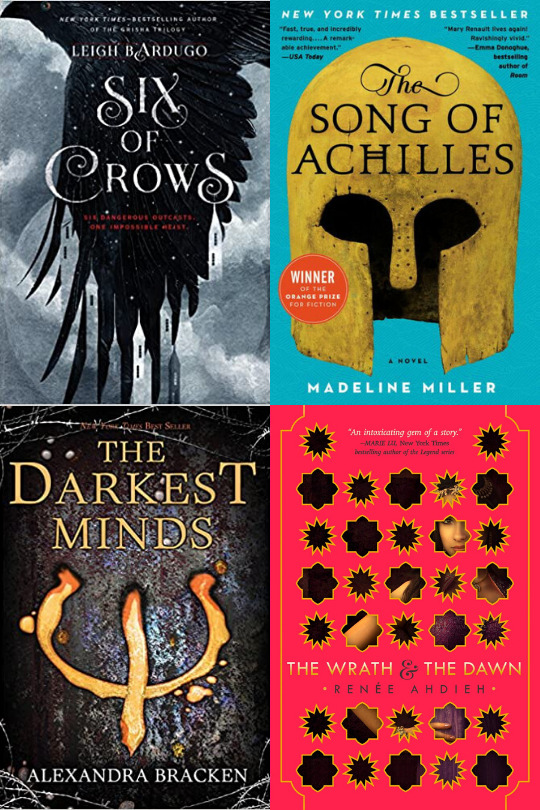
6th Step - Six of Crows by Leigh Bardugo - Fantasy
This book is definitely a step up in complexity as it contains more intricate world building and plot development than any of the previous books on this list. It’s about Kaz Brekker and his band of criminals (some with magical elemental powers and some with other fighting skills), who are tasked to break into the most secure place in the this fantastical world and extract an important person from it. The content and twists of the heist are super interesting and action-packed, and will definitely pique all different types of readers’ interest. Its romance is subtle and slowburn and contains three different types of romantic arcs varying from enemies to lovers, to co-workers to lovers, to idiots to lovers. There’s also queer representation. It’s really all encompassing and has something for everyone’s romantic tastes. I’d recommend it for readers who want the same kind of dark fantasy vibes as Wicked Saints, but a slower and more diverse set of romance arcs.
7th Step - The Song of Achilles by Madeline Miller - Greek Mythology/Historical
Warning: This book is devastating and will make you cry. Achilles, “the best of all the Greeks,” son of the cruel sea goddess Thetis and the legendary king Peleus, and hero of the Trojan War, falls in love with Patroclus, awkward young prince exiled from his homeland and brought to live with Achilles. This book is definitely more mature in its romance, as its probably the first book in this ladder that depicts a sexual scene, albeit a very short one. I think YA readers should be able to read this book with no problem. I believe YA readers should have access to these kinds of scenes/books in order to figure out if they like them and if they do, we shouldn’t shame them. Sexuality and sex shouldn’t be taboo subjects! This book definitely is also much more emotionally heavy and centers the relationship/romance aspect as the main focus. I’d recommend it for my older, more mature readers in the 11th-12th grade.
8th Step - The Darkest Minds by Alexandra Bracken - Dystopian Thriller
If readers want a break from the super fantasy/rich romances of the previous books, I’d recommend taking a good break with TDM. TDM is about Ruby, a young girl who has mind-reading abilities in a post-apocalyptic America. She escapes a camp designed to control and lock people with abilities like hers and travels with a band of kids like her to a safe haven. It builds off of the emotional complexity of The Song of Achilles, but in a different, more relatable way. Because it takes place in a post-US world, the characters’ dialogue is reminiscent of ours and so readers will be able to really relate to the characters and become really invested in them. The romance in this book is slowburn, a good followup to Six of Crows and The Song of Achilles, but the romantic dynamic is similar to that of earlier contemporary books like Simon and TATBILB and Emergency Contact. So, this book is not necessarily more sophisticated than the other books, but it is a different choice that readers can make when choosing books with romance to read and offers a breath of fresh air to the previous more prose-y books.
9th Step - The Wrath and the Dawn by Renee Ahdieh - Fairytale/Historical
A classic young adult retelling of the Arabic/Middle Eastern fairytale of One Thousand and One Nights, where teenager Shahrzad volunteers to be Khalid’s, the eighteen-year-old Caliph of Khorasan, new wife, after her best friend died at his hands. She is determined to not only stay alive, but to end the caliph’s reign of terror of killing young women brides once and for all. This book is really romantic-heavy and is similar to Wicked Saints with its’ enemies to lovers arc and dubious dynamics. However, it’s compelling and exciting with its fairytale elements and offers a diverse romantic story for readers who want something new and who want to stretch themselves beyond American-centric romantic stories, a callback to Warcross, which takes place in a futuristic sci-fi version of Japan. Because this book is heavier on the prose, I’d recommend it for readers who also want a slightly more complex read on a sentence-structure / description level.
Grade Level: 12th and older // Reading Level: 10th - 12th

10th Step - A Court of Thorns and Roses by Sarah J. Maas - Romantic Fairytale Fantasy
From this point forward, these books will contain explicit sexual romantic content. While many folks will argue that there is no room for these kinds of scenes in YA books, I’d argue that by omitting access to such content (specifically explicit sexual scenes where consent is displayed), students will go out and find books that will show explicit sexual scenes that don’t show consent and they will learn from them. I think it’s better to not limit certain books from readers and let them decide for themselves if they’re uncomfortable with it or if it’s inappropriate for them. This book is perfect for folks who want a fairytale fantasy twist on the classic Beauty and the Beast story. It stars Feyre, a huntress, who ends up being kidnapped by the Faerie High Lord of Spring, Tamlin, for taking the life of a faerie. Once in the land of the faeries, she enters an enemies to lovers romance with Tamlin and discovers there is more beneath his exterior/mask. I’d recommend this for folks who want an extremely romance-centric story with one sex scene and an enemies to lovers arc. It’s also in the same level of complexity as The Wrath and The Dawn; it just centers around a different fairytale.
11th Step - Red, White, and Royal Blue by Casey Mcquiston - Adult Romantic Contemporary
This book has multiple sex scenes. This book takes place in an alternate 2020 where Trump never became president and stars a man-loving-man relationship. Alex Claremont is the first biracial, bisexual Son of the First Woman President of the United States. He enters a secret romance with the Prince of England, Prince Henry, who is gay. This is one of my favorite books ever, if not my favorite book ever! I’d recommend this for anyone who wants an escapist rom com from the trashfire of a world we live in right now. I’d also recommend this for older, more mature high schoolers who want to understand American politics better and read contemporary, relatable, funny dialogue with a rivals to lovers romance. And lastly, I’d recommend this book for readers who want a callback to the first couple of books on this romance ladder, but with a more complex/sophisticated plot and character work.
0 notes
Text
Dear Blog,
Prompt: I want you to look beyond the class to see what is being said about YAL in English teacher education. Go explore and find a blog, article, website, etc. that focuses on using YAL with secondary students. Read deeply and see what they offer, then write a blog post where you talk about what you found, with a link, and why you found it important.
I stumbled upon this amazing academic article titled, “YAL as a Tool for Healing and Critical Consciousness: An International Perspective” by Jurana Aziz, Philip Wilder and Raul Alberto Mora. Click on the title of the article to direct yourself to the actual text.
In this article, I learned YAL can be used as a psychological tool across cultures. To be more specific, this article asserts what many of us in the cohort seem to know: “teachers can foster empathy for affected learners by using YAL and related texts (including those emphasizing mental illness and trauma) in their language classes to reflect the lived experiences of students” (72). So, culturally relevant pedagogy though the incorporation of YAL and the examination of its themes and characters! Yes! Representation in the books you’re reading to create confidence in students! Yes! But the article further argues that “the use of YA texts can create awareness of oppression and psychological trauma, while fostering equanimity among students” (72). In particular, “awakening to the tools of oppression and to their internalized conditioning frees students from the heaviness of limitations and the identities others place upon them” (72). To restate, YAL has the power to make us woke...to make us less ignorant...to make us aware of the racist, classist, sexist, ableist, imperialist, and homophobic BS we have internalized over the years and to work on dismantling them within ourselves and in our society. And it all starts in the critical consciousness, the mind. However, for students from the Global South, it is more than just a psychological tool to critical consciousness...it can be a form of healing from the neo-colonial forces of globalization that often perpetuate oppression in the lives of students from the Global South.
The authors of this text speak from a Global South perspective where they examine how much of the education they receive “remains heavily influenced by global educational organizations -- both their funding and their underlying neo-colonial ideological assumptions about literacy” (72). That is, much of the idea of literacy that is taught to these students in schools revolves around using their ability to read and understand what they’re reading for the labor market and individual production (aka a very white capitalistic POV). While literacy can foster social empowerment and critical consciousness, it can also be weaponized as a means to whitewash and assimilate and erase an entire group and country’s culture for the purposes of neo-colonialism and Western imperialism, the growing economic pursuits of the Global North, which often create “violent external and internal realities for the students living in the Global South such as police brutality, educational famine, gender discrimination, neocolonial greed, class conflicts, poverty, climate crises”, just to name a few (73). How this relates to YAL is in YAL’s ability to awaken people’s minds to the idea of action and revolution to doubt and question everything they have been told to believe about themselves, and it can also operate as a tool of healing. Finding critical consciousness in YAL “teaches impoverished students how oppressors steal and yet cannot define their inherent worth. Consciousness teaches queer students how the discourse of the oppressors maintains discriminatory laws but cannot define their inherent worth. And in the face of oppression and regardless of how others define the self, consciousness births freedom through agentive self-love” (73). The authors’ framework of finding self-love and agency in the critical consciousness they receive from reading YAL is so profound...so powerful....because I also agree that YAL can serve as a healing mirror to students and teachers as a truthful way of seeing the world and themselves, and how they want the world and themselves to be seen by everyone else. It is honestly so...healing! (HEALING!) when you see your experiences reflected in the books you read, and it also so healing to see how to dismantle a world full of oppressions and how to reimagine a new world. And YAL does that!
I found this point to be particularly interesting given that the article itself is written in the colonizer’s language -- and I’m speaking in the colonizer’s language. It doesn’t go over me that in order for me and for much of YAL to awaken the colonized’s mind to the oppressions they have endured and are enduring, we must speak in the colonizer’s language, due to the fact that English is increasingly becoming a global language.
Overall this article argues for a more globally conscious teaching practice with YAL and provides advice to teachers to incorporate and value more of the perspectives of those living in the Global South when it comes to teaching and learning from YAL. The article also presents four guidelines for using YAL to heal and raise student and teacher consciousness that include: (1) adopting a conscious stance as a teacher, (2) closely observing students’ lives before selecting YA novels, (3) practicing compassion -- for the self and for students, and (4) rethinking the selection of texts beyond traditional milieus.
YAL is not a local American niche. It is a global phenomenon, and it has the power to “help students and teachers turn their classrooms into spaces for safety, community, and restoration” as well as “offer students mirrors in which they are reminded and awakened to the permanence of their worth” (76-77).
0 notes
Text
Dear Blog,
Prompt: This week I am going to have you read two articles on young adult literature that show both how we can use YAL to consider how adolescents are taught reading, and also how YAL can be used in traditional literary analysis expected in secondary English classrooms.
Write a blog post where you react to the two articles you read this week. You can do separate sections or even separate posts to reflect on what you read. Do they change your thinking or reinforce what you already thought?
In “Reconsidering the Hypothetical Adolescent in Evaluating and Teaching Young Adult Literature,” by Mark A. Sulzer and Amanda Haertling Thein, the authors conduct a study to evaluate how the “pedagogical practice of asking preservice teachers to read and evaluate YAL by imagining the needs, desires, abilities, and experiences of their future students...rhetorically structures preservice teachers’ stances towards adolescence/ts” (Sulzer and Thein 164). In other words, how does a pre-service teaching class where future ELA teachers read YAL books frame and position young people -- and how might these frameworks and positions turn out to be false compared to the current reality of who young people actually are and what they care about?
According to the study’s findings, one of the rhetorical strategies that the authors located was called “the matching strategy” where future ELA teachers “articulated a vision of adolescent needs and matched those needs to the message or lesson of the novel” (Sulzer and Thein 166). They found that the preservice teachers would read a book, interpret its content/themes, and evaluate it based on its potential of teaching a young person the lessons that a “typical” young person would need to learn, given that the young person was a straight, middle-to-upper class white American, among other privileged identities. Content/themes that deviated from the “normative (white, middle class, heterosexual, and able-bodied) adolescent experiences were both rhetorically and pedagogically marginalized, as were textual themes that might speak to a wider range of questions and experiences” (Sulzer and Thein 166).
I found this finding to be really interesting, because I have definitely seen it occur a few times in the discussion posts and zoom calls in our YAL class. Due to the fact that most of the people in our cohort are white, middle to upper class, presumably straight American Christian cis women, there’s a limit to the kind of analysis of themes and content in the diverse YAL books that we’re reading. While everyone seems to have good intentions and are coming to these books with an open and empathetic perspective, I have noticed that what preservice teachers deem as “relatable” for adolescent readers are the kind of adolescent experiences and feelings that seem “universal,” but are actually very individualistic, selfish white American experiences and feelings that in reality, a lot adolescent readers who are BIPOC can’t relate to. There’s a presumption that there’s a set of “universal” feelings, if not experiences, that everyone goes through, some examples include feeling insecure as your body and emotions develop, finding love and new relationships, developing confidence as you become a young adult, becoming angry at your parents and realizing that they’re people too, etc. But not everyone can relate to that. Not everyone experiences that during their adolescent years. Truly. And I think some of that blame has to be put on students being taught in K-12 American school about the “typical” hero’s journey by Joseph Campbell (who is actually pretty racist...) -- and the “typical” narratives, archetypes, and motifs you’d find in Western stories. And some of the other blame can be put on the not-very-diverse makeup of our cohort and our faculty.
We can teach as much culturally relevant pedagogy as we want and include as many diverse YAL books as we want, but if we do not address the very real systemic issues present within the individual demographical makeup of the English Education cohort and faculty, and actively create an environment where more BIPOC students and teachers feel welcomed and safe to be included and voice their perspectives, as well as be able to enact change, then we’ll never be able to adequately address the apparent disparities in how preservice teachers evaluate YAL books with their questions that are used to frame their interpretations, and thus, adolescents.
In “What YAL Tells Us About Learning, Schooling, and Teaching,” by T. Hunter Strickland, the author conducts a study on the traditional narrative arc of the “young nobody as protagonist, who, under the guidance of a wise mentor, comes into possession of a symbolic object of power, and then must complete a quest or series of quests with their loyal companions, where they will come across many obstacles before ultimately facing their downfalls because of the protagonist’s character flaws” (Strickland 18). More specifically, Strickland evaluates how new YAL stories that use this narrative arc speak to the types of learning, schooling, and pedagogy present in the teachers, students, and curriculum in our real life schools. What are the parallels? How can we understand learning and teaching in schools in the US by what is being shown in the YAL texts we’re reading? What is being valued and/or prioritized in schools in the US given what we see of the mentor and mentee relationship reflected in so many of YAL books read throughout time? What is not being valued and/or prioritized?
According to the study, “examining how learning and teaching are represented in texts that our students engage with is important because we want our students to know that learning is not perfect, and then help them to be critical examiners of the pedagogical spaces that surround them” (Strickland 19). I really agree with this point. While I have not read Scythe by Neal Shusterman, I have read plenty of YAL stories that incorporate a narrative arc where the young nobody upstart protagonist at first idolizes their wise mentor and follows every single lesson that is being taught to them, believing their mentor to be someone who has all the right answers...only for them to realize that their mentor is an imperfect human just like them with hopes, dreams, and flaws, and only has so many answers that are more often than not, incredibly biased. The protagonist must then challenge their mentor and seek their own answers, in order to become their own person -- and perhaps become a mentor to someone else. I have found this experience to be especially true when we’re young and more impressionable. We tend to look up to the adults in our lives, teachers especially, and put all of our hopes and dreams in their hands, praying they’ll guide us safely to the answers we want -- but, not necessarily need. How old were you when you realized that the adult and mentor figures in your lives were imperfect humans and didn’t have all the answers? I was probably 15/16 years old, but it definitely crystalized for me when I was 18/19 years old. And that’s when I grew up.
In the article, Strickland discusses the idea of this old/new binary and how it can lead to some interesting thoughts on education. “We would be lying if we did not think that education has a problem with new fads versus traditional pedagogy” (Strickland 21). In other words, much like it is presented in YAL novels, there is a tension in the education world between old and new methods of teaching and learning. “The problems in education can be solved, so some would have us think, with the next new teaching method...or students would learn if only our countries would invest in the new education-in-a-box kit...” etc (Strickland 21). Which is better? The old ways of the wise, but imperfect mentors? Or the new ways of the hopeful but naive new generation? Where is the balance between those two? Should there be a balance? Is the binary between old/new teaching and learning styles actually a binary -- or is it more complicated and fluid than that?
Given all of this food for thought to chew on, I immediately think of activism, particularly modern young activists looking to create some real change in the world. Especially given the Black Lives Matter movement, I think about how it is important that we root ourselves in the works of liberation and radical thinkers and the histories of liberation-focused movements. Following only on headlines and news will have us swimming in despair or stuck in an intellectual drought. There were people before us. There were Black revolutionaries, scholars, activists, thinkers who have written works on anti-racism and how to combat white supremacy. Mistakes on the left have been learned. We must read them, listen to them, and learn from them.
I also think about one of my favorite “YA” movies: Star Wars: The Last Jedi (a story about an adolescent Rey learning under the guidance of the famous Luke Skywalker and becoming the new leader of a new generation of Jedi)-- and one of my favorite quotes from that movie, spoken by arguably the most iconic wise mentor of them all, Yoda: “But weakness, folly, failure also. Yes, failure most of all. The greatest teacher, failure is. Luke, we are who they grow beyond.” It’s honestly one of the most emotional moments in the movie for me because it articulates a lesson many of us teachers sometimes refuse to accept -- and the kind of potential many of us learners do not realize we possess.
As future teachers, we have to acknowledge that we are always learning and are not perfect, and that the future students that we teach will one day surpass us and not only pass on the the parts of our knowledge that resonate with them, but also learn from our mistakes. In addition, as preservice teachers, we have so many great mentors to learn from and we must respect that there are people who have gone through what we’ve gone through and can help us. But also as simply students, we have the responsibility to ourselves and to the new generation to take what we’ve learned, critically examine it for its flaws and gems, and form our own pedagogical stances and teaching practices.
So, to summarize, the binary between old and new teaching and learning narratives present in so many YAL stories is actually less of a binary, and more of a complicated case-by-case situation -- and this is a good thing! Because the real world is so much more diverse than we will ever be able to perceive, with so many lessons we have not yet had the privilege of learning, that it should comfort us to know that what is being valued in many YAL stories is this idea of teaching and learning as something fluid and organic and emotional and complex and very very very human.
0 notes
Text
Dear Blog,
Prompt: In this week's blog post, please think carefully and critically about the ideas raised by Kittle. What does she share that complicates or challenges your thinking about teaching with YA literature - or supporting independent readers in your classroom work? Are you coming from a similar or different position when it comes to your own plans for your classroom? Does she complement Beuhler or are these totally different voices? Or, in other words, tell us about YOUR developing YA pedagogy (which will absolutely continue to evolve throughout our work and study together).
What does she share that complicates or challenges your thinking about teaching with YA literature -- or supporting independent readers in your classroom work?
In Chapter 2, “Understanding Readers and Reading,” Kittle argues that in order to improve reading, “students must practice reading skills in a text better matched to their ability and then continue to encounter more challenging texts as they increase volume and stamina” (15). Kittle describes how the rise of social media has led many folks, especially young students, to find more value in reading texts that are succinct in language and efficiency. In other words, the shorter and more punch-y the text, the faster it is consumed and better it is liked. Therefore, when students are presented with a longer, more complex text containing purple prose, inaccessible vocabulary, and a slower plot than they’re used to, they become frustrated with their inability to understand, and their motivation to read diminishes. These facts require teachers to approach each student with not the expectation that they’re at the same reading level as their current grade or higher, but with patience and empathy as they work with their student to build their capacity -- or stamina -- as an independent reader in texts they can understand, rather than forcing them to read books that are both hard and uninteresting in order to meet a curriculum requirement or a state standard. As Kittle suggests, “we teach students first, then curriculum. It is not going to be easy to lead all our students to literature. But we can’t give up, either” (15).
I’m going to tell you a secret. Well, more like a hidden shame. For some time now, I haven’t called myself a reader. In other words, I no longer identify as a reader, which is sad, because ever since elementary school, I’ve consumed books. I used to consider myself a voracious reader. In fact, I would read several books a day! It helped that my elementary school had a reading challenge program, where students would win prizes if they read a certain number of books per month. While I initially used my school’s reading challenge program as motivation to read, I eventually began to read books outside of the program’s lists, and out of my own volition, without a reading program to push me to read more and more books. Over time, my reading stamina grew and when I got to middle school, where there was no such thing as a reading challenge program, I was going to the media center practically everyday to check out a new book. I became a certified bookworm. My self identity and confidence became nearly inseparable from my ability to read books as a fast and passionate reader.
But when I got to high school, everything changed. The first two years were fine! I was sneaking around teachers, trying to read my books underneath my desks, hoping they wouldn’t see. I couldn’t tell you how many times teachers would take my books and put them on their desks or in the front of the classroom, scolding me for not paying attention to the lesson. It was one of the few times when teachers would tell me to not read so much. This was what I meant in my previous blog post by “stealing time” to read books, by the way. I was that kind of reader. When I entered the 11th grade, I started to have less time to read books as I took on more AP classes. Normally I’d make time to read, but even when I did, I began to have less and less motivation to read books for fun, because I was either so exhausted from all the homework I had just completed, or I was too busy reading other, more academic texts for my classes. I also developed depression and anxiety from both the circumstances in my school and home life, and as a consequence, I no longer found books as a source of pleasure and escape. I was too mentally and emotionally drained to enjoy a book, because my mind was either racing or unable to focus on a few sentences at a time without itching for my phone or to go to sleep. Because I was preoccupied with just surviving, over time, I had lost the strength and will to read for pleasure. And it has only gotten worse in college.
I tell this story to provide some context for what I am about to say now. Before reading Kittle, I had believed that my ever increasing inability to read and finish a book was my fault. More importantly, I had believed that I could never overcome this obstacle of reading, and that I had lost the ability to read books for fun for good, because I knew I was going to be chronically depressed and anxious for good. But after I read Kittle, I realized I wasn’t the alone in my experience. There were so many other students out there who experienced the exact same thing and felt the same exact way as I did, as evidently pointed out in Kittle’s articles. It made me wonder if a part of the reason so many students feel this way is because our current public education system fails them and creates circumstances that don’t encourage students to read and also crushes them with so much work at an early age, where they’re told their value is tied to their labor, thus they feel the ever growing pressure to succeed in a white capitalistic society, that they eventually become overly perfectionistic which causes their depression and anxiety, all because they cannot perform to what our society deems is the standard........ANYWAYS.
In addition, Kittle articulated in words how my supposed “reading deficiency” wasn’t really a deficiency, but rather a result of a set of circumstances that has created a new form of reader in me. While I find it hard to read the kind of books I used to read as a middle and high schooler, and at the same pace, I am still a reader. With the help of teachers, if I bide my time and steadily seek out pleasure in reading something, anything, before I push for a longer, more difficult text, I can begin to rebuild that strength...that stamina...for reading again. Before reading Kittle, I had never viewed reading through the lens of stamina before -- and this perspective really challenged me to view reading, as both a student and future educator, as something I can always rebuild and retrain myself to do again. It’s like a muscle...or a skill...you always have to keep working on it in order to maintain it. As Kittle asserts, “when skills and pleasure align, students begin to choose more difficult texts to read independently” (Kittle 14). When students and teachers work together, both will find fulfillment in both the reading of books and the teaching of reading. But both will have to understand that it is process and a slow building of blocks, rather than a race, to become the kind of a reader you want to be.
This was a really long answer for one question. My b.
Are you coming from a similar or different position when it comes to your own plans for your classroom?
In Chapter 3, “Building Stamina and Fluency,” Kittle argues that “it isn’t enough to encourage kids to read outside class and expect somehow that it will happen. But it is also not enough to have kids read one easy junk title after another” (33). I agree with this point of view. I believe that in order for students to progress in their ability to read, they have to have time to read for pleasure and for fun in the classroom in order to develop the will to read -- and to have those books they read challenge in them in different, not necessarily linear ways in order to build the skills to read. In my classroom, I want to set a time at the beginning of the year where students can curate a list of books they will read for fun, (much like this YAL class), and then at the beginning of each class period, for 10 to 12 minutes, they will have time to read the books they had chosen and engage in discussions with their peers about them. More specifically, I want to help students create their personal reading list and make sure they have variety and a diverse set of complexity that will build them as readers over time, as well as create a unit where them reading these books for fun and a challenge serve a larger purpose (not grading them though), but for the purpose of growing as learners and complex thinkers.
Finally, as Kittle also states, “it’s all about balance” (34). Students are like us, humans who sometimes just want to take a break after a serious, long day of learning and tune into something or scroll through their phone where they don’t have to think too hard. I do this all the time! Social media is so addicting! My brain just wants to rest! But, if I want to become a lifelong, satisfied reader, and if as teachers, we want our students to become lifelong, satisfied readers, we have to create “a balance between the careful study of complex texts and time to pursue personal passions in books of choice for pure pleasure” (Kittle 34). And the key is “we have to teach both” (Kittle 34).
Does she complement Beuhler or are these totally different voices?
I definitely think Kittle complements Beuhler, Beuhler states in his chapter that students must be given a balanced reading diet. They need room (specifically time and space) to discover new books written by people who aren’t dead old white dudes. Similarly, in Chapter 4: “Opening Doors into Reading,” Kittle argues that in a yearlong English class, “we need to create a balance between (1) studying literature (whole texts), (2) reading shorter mentor texts (in all genres) to understand the writer’s craft and create a vision for what we ourselves will write, and (3) developing an independent reading life” (52). While Beuhler is specifically arguing for the case of YA literature and how a diverse set of YAL books will create a balanced reading palette, Kittle is using the same terms to also argue for a balanced reading palette in regards to a yearlong breakdown of different forms of texts to engage with. Additionally, Kittle is also arguing that when building a classroom library, there needs to be a balance of complex diverse genres that will intrigue different types of readers looking for different forms of reading fulfillment. It’s practically the same philosophy Beuhler preaches in his chapter! Beuhler also advocates for meeting students where they are and creating the conditions for students to become lifelong readers. Beuhler and Kittle are operating on the same wavelength!
Or, in other words, tell us about YOUR developing YA pedagogy?
I honestly think my developing YA pedagogy is to line my shelves with diverse, interesting YA books, with an emphasis on own-voices books written by BIPOC authors and developing a conversational relationship with my students filled with trust “where I meet them where they are, accept where they are, and then put books in their hands that will ignite their own intrinsic motivation to read” (Kittle 35). I also think that if I were honest with my students about my own reading challenges and philosophies, I’d be able to engage with them on how to rebuild their capacity to read, develop their own reading strategies, and making it so that if I grow as a reader, they can grow with me. We’re all on this journey together -- and no one has to be alone.
0 notes
Photo
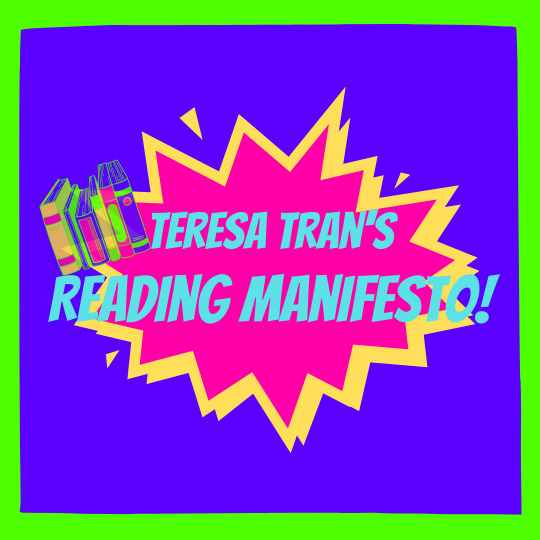

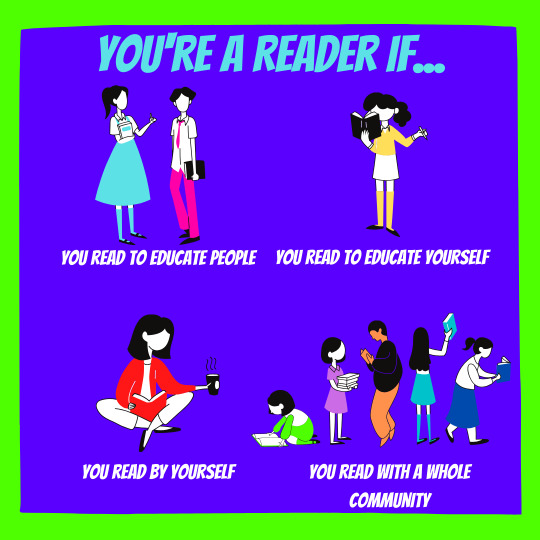



Teresa Tran’s Reading Manifesto: You’re a Reader If...
0 notes
Text
Dear Blog,
Prompt: Write a new blog post with your reaction to the Beuhler chapters that you read for task 3 this week. How does Beuhler's work match with how you view your new role as an English teacher? What experience did you have with YAL in middle or high school? You will go more in depth with Beuhler and YA pedagogy in the fall.
Beuhler’s Chapters 1 and 2 discuss reading YA books with passion and purpose, and viewing YA literature as complex texts as teachers who will one day teach and share YA books with their students.
One of Beuhler’s tenets is in order “to learn, grow, and thrive, what all of these students need is...a wide landscape for reading” (Beuhler 3). That is, most students view reading as a chore, because for many of them, it is something they have to do, over something they want to do. It is an assignment. It is an expectation. It is another box they have to check off the list or a line they have to cross of on the agenda. And because they’re required to read mostly classics written by dead old white dudes, they’re “cut off from the larger world of literacy” (Beuhler 3). Because students aren’t directly told or handed diverse reading options, they fall out of love with reading and don’t develop that muscle of reading for later on. That is why many students, my friends, and myself included, over the years, began to repeat the sentiment of “I’m not much of a reader anymore.” It’s depressing!
But as Beuhler states in his chapter, students must be given a balanced reading diet. They need room (specifically time and space) to discover new books written by people who aren’t dead old white dudes. They need motivation to seek out those books. They need to hear from their teachers that them reading for “fun” and as a “hobby’ is not only good for them, but also encouraged in their ELA classroom. There needs to be room for students to develop their own reading tastes and reading stamina, but they can’t do that if they’re not allowed to employ a sense of agency within their choice in books. It is only through this sense of agency and a diverse palette of YA books will students begin to see reading as less of a chore, and more of a fun activity they can’t wait to do.
This text also made me think about the multiple ways I, as teacher, can do to encourage this love and space for YA literature in the classroom. First, I want to create a space where students who already possess a love for reading YA books outside of the classroom don’t have to steal time to read inside the classroom. In other words, I want my classroom to be a place where students will have a dedicated time to read their contemporary YA titles and keep reading logs about them and talk about them with their peers. I don’t want my students who already consider reading as a hobby to ever feel like they have to sneak around me and the state-mandated curriculum to read their YA books -- and then be afraid I’ll take their books away from them, like the many times teachers did this to me. (I still think about these moments all the time...even in college. I lowkey have some trauma from that LOL).
Second, I want to create whole entire units around YA literature. But this might require going against state standards and school subject departments. So how can I make the case for YA lit in the classroom? Beuhler suggests marketing them as an outlet and/or case study for students’ personal and academic growth. The thing about YA lit is that it is entirely written for them. “YA list offers a way to meet students where they are now -- not just as readers, but as teens who are still figuring out their place in the world...YA lit honors that process of self-discovery” (Beuhler 3). When students read YA lit, they grow as the main characters grow. When students read YA lit, they see their personal journeys and feelings of adolescence (going from young child to young adult) paralleled in heightened and relatable ways. When students see themselves reflected in the literature they read, they end up feeling less alone in the world and develop a sense of community with other students who feel similarly.
When we think about young adult students, we also think about puberty. We think about the multiple weird strange awful beautiful changes that happen physically, emotionally, mentally, and socially for them. We think about our own experiences during that time and how equally tumultuous it was for us. YA lit offers itself as a space for students and people in general to put their feelings and weirdness somewhere, where it’s private and peaceful and doesn’t make adolescence any more more embarrassing than it already inherently is.
In addition, when students read YA lit, they grow as readers. “If students in our classrooms might not have been readers in the past, but they can become readers now -- if we create conditions that support their individual development” (Beuhler 6). When making the case for YA lit in the classroom, I will emphasize how YA lit creates that confidence within students to believe that reading is something they can do. YA lit inherently has qualities that push students to motivate themselves to continue reading and develop a stronger reading muscle for heavier, longer, and more complex YA texts. YA lit makes reading accessible, breaks down barriers, enhances reading comprehension and critical thinking skills, and promotes a sense of creativity, all of which are qualities state standards try to achieve for students but can’t.
And third, Beuhler talks about how his favorite YA novels are “those that defy categorization” (Beuhler 27). I think about how not only young teens, but kids and adults and seniors are reading YA lit more and more over other categories. Why? It’s because YA lit does so much at once to fulfill their reading and personal needs. They’re complex and rich and tackle so many relevant themes and experiences, but probably most importantly, they model a development arc that many folks are always secretly seeking. That sort of adventure of becoming into one’s own and developing confidence as a person with better informed opinions and forming new friendships and relationships with people. For kids and teens, it’s the excitement and hopefulness of growing older and breaking away from adult authority and becoming your own person. For adults and seniors, it’s the nostalgia and also hopefulness of returning to what youth was like and experiencing new things again. Because there is so much complexity in YA lit, it will require a complexity when teaching YA lit.
As a teacher, I want to change the conversation about YA lit, dismantling the idea that it’s a category mainly for teenage girls, which, btw, what the hell is wrong with THAT? So what if it is mainly saturated with stories for and about teenage girls? Most of the books students have had to read have been led by boys and men and written by men -- and students of all genders have had no trouble reading them. But when suddenly girls’ and women’s perspectives are prioritized in narratives, or a category is predominantly centered around the experiences of girls and women, suddenly it’s beneath people and not as complex as other categories? Can someone say SEXISM?. While some people might argue that that is not why they view YA books as not nearly as “complex” as the classics, I think there’s no mistake that gender plays a big part in informing that particular mainstream point of view about YA lit.
Furthermore, alongside Beuhler, I also believe that “sometimes calls for increasingly complex texts are really code for keeping classic literature at the center of the curriculum” (Beuhler 28). More specifically, I believe that most people’s calls for “complexity” in their reading, what they’re really calling for is either
(1) books written by dead old white dudes about the American Male ExperienceTM where they find excuses to be racist or sexist or BOTH (fun!) and argue that it’s a relatable part of being an American Man (which ew! and wow, the bar is low), OR
(2) books written by BIPOC authors that focus on the “Authentic” experience of being BIPOC, but mostly as a vehicle for white folks to fetishize the trauma and pain of BIPOC, without neither the actual empathy and compassion for BIPOC, nor the active commitment to creating systemic and individual change against the trauma and pain that BIPOC often face living under the white capitalist patriarchal police state that these books are often thematically preaching about.
Here’s the thing. YA lit definitely can perpetuate those same harmful practices that the classics often do. In fact, some YA novels already do. I can point to many of the YA Book Twitter drama that rightfully calls out problematic books, such as The Black Witch, on the daily. However, YA lit has shown over and over again that it can reach far beyond its intended target audience and tackle complex themes without infantilizing, again, their intended audience...which is young teens. The thing about literature and education and the passing on of information in general is that if you are an academic or a student or a teacher or an individual and you can not relay your perspective and/or argument in such a way where another person can understand it (even if they might disagree with it)...you have failed.
YA lit is an example of when perspectives and themes and experiences that are often considered “complex” is successfully communicated to a young teenage audience because of its accessibility. If a classic cannot reach a bigger audience or in this case, reach a young teen demographic, it’s not because of a complexity that YA lit “lacks,” it’s because of the unnecessary, often racist and sexist gatekeeping in classic literature that privileges upper class white folks and their experiences which are often communicated in a language only other upper class white folks can speak and understand. Think about how many classic books are written in AAVE, aka African American Vernacular English? Most people will think of Toni Morrison or James Baldwin...but those are only two Black authors. Two. Out of how many white authors? However, I can think of countless YA lit books written not only in AAVE, but also different Chinese, Spanish, and African dialects by Chinese, Spanish, and African authors. As a teacher, I want to use all of these arguments and evidence I’ve just laid out to argue for the case of YA lit in the classroom.
I always viewed my role as an English teacher as one with deliberate purpose. I’ve always wanted to be more than just an English teacher. I wanted to be the one person whose students would go to when they finished a book and wanted someone to listen to them rattle off about the parts they liked and didn’t like. I wanted to be the one person whose students would look to when they got bullied by other students or teachers and protect and comfort them, especially my fellow students of color. I wanted to be the one person whose students would ask for book recommendations and ask to read over their writing projects because they trusted my opinions. I wanted to be the person I needed when I was younger. If I can’t go back in time to the past, I’ll make sure I become that person in the present for the kids of the future generation...
And I’ll start with introducing them to YA lit.
0 notes
Text
Dear Blog,
Prompt: For your final blog post for this class, I would like you to write how you currently view YAL. This could be reflection on the genre as you have read further this summer. It could be how you feel about using YAL in a classroom now that we have started to discuss it. You might include questions you have now that you want addressed in the teaching adolescent readers class in the fall. Please write about how what you have learned and done in this course matters to your future students and classroom work. Where have you struggled? What are the big ideas that might inform what you do next? Will you be a teacher who reads? What do you need subsequent courses to help you discover when it comes to YA in our classrooms? And, what are you eager to read next?
Prior to this class starting, I knew I would be coming into this course with a robust love and knowledge of YAL. I’ve loved YAL since 6th grade. I had written in previous blog posts about how much of an avid reader I was and how many big YAL authors I follow on social media and whose books I already owned. I had showcased my knowledge about the YA publishing world, YA Twitter, and YA in popular culture, as well as briefly talked about all the research I had done on the parts of a YA novel. This class didn’t need to try to convince me to love YAL. I had done all the heavy lifting beforehand.
This being said, when I finally began this class, I was surprised to learn how out of touch I was with YAL. Many of the books on the YAL list for this class were books I’d never heard of -- or were books I’d heard of but had not yet read due to a variety of reasons. This fact really fulfilled my hopes that this course and the subsequent major and education field were more caught up to speed and more open to texts written by diverse BIPOC YA authors than I had initially given them credit for. I really enjoyed getting to read books that young Teresa would’ve loved and sought on her own, allowing me to catch up with all the great stories that YAL had produced in recent years.
Despite this, I definitely struggled in this class. There were a few times where I fell behind the reading schedule because I wasn’t used to reading two large YA books a week. I also struggled with the online context of this class, where I didn’t get to see my friends in the cohort as often as I would’ve liked (although the asynchronous and synchronous Zoom discussions really helped for the weeks they were mandated). At the beginning of the course, some of the assignments felt repetitive to me so I had to wrestle with multiple assignments asking me of the same things. Towards the end of the course, I got to make graphics with some of the books I read for this class and build reading lists, which I loved, but because I was so ambitious with my ideas, I struggled to submit them on time.
Nevertheless, I think my most favorite aspect about this class was, strangely, the blog posts analyses. I really enjoyed putting my literary analysis, critical thinking, and women’s studies writing skills to use and applying them to an education/YAL context. Through my writing, I found connections between feminism and kidlit. I became a stronger, more argumentative, and more persuasive writer. I was able to flex my academic scholar attributes, while also imbue my blog posts with my voice and personality. As a result, this class has allowed me to build a blog where I can place my thoughts about YAL in posts that I’m honestly very proud of -- and excited to share with my colleagues. This class has persuaded me to keep this blog going and continue to write more blog posts about YAL outside of this class, putting articles and authors into conversation with one another.
After this class, my hopes for the upcoming fall semester include being able to use this blog in more than one instance. I want to take advantage of this space as a sort of online journal. So as opposed to a writing notebook...I’ll maintain a writing blog? I really like that idea. And I would also just love it if we continue conversations about YA and reading YAL in our future teaching courses.
Overall, this class has taught me how to argue for the case of YAL in classrooms despite what the state curriculum says -- and how to build intentional reading lists and create meaningful assignments around YA books. This class has really made me pause to consider how much reading YA books matters in the process of teaching YA books. You can’t teach what you haven’t experienced, right? And this class has allowed me to gain a variety of new perspectives on for the necessity of diversity in the YA books we teach and give to students to read -- and how to argue for its’ case and place in the secondary education classroom.
Lastly, I’m super eager to read the unread YA books on my bookshelf. If there’s anything I learned from this class, it’s that YA is really magical and worth my time and struggle.
0 notes
Text
Movie (or TV) Recommendations for Ari and Dante from“Aristotle and Dante Discover the Secrets of the Universe” by Benjamin Alire Sáenz
Prompt: From all the movies (or television shows) you’ve seen in the last couple of years, pick five you would recommend that your character see. Give a brief summary of each movie and explain why you think the character should see it.
Love Victor, Season 1 - Disney Plus
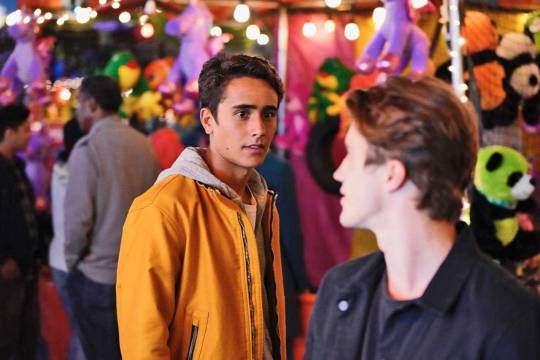
A closeted Latinx gay kid living in the south with working class religious Catholic immigrant parents, crushing on boys and trying to figure out his sexuality. Sounds familiar? Ari and Dante...this is literally your experience but in the 21st century. Hop on it.
Druck, Season 3 - Youtube

The German remake of the popular Norwegian teen show SKAM. Season 3 is about Matteo, a depressed, weed-smoking, closeted gay German kid, who has a crush on the new dark handsome boy in school, who also has a secret of his own. I think Ari would relate to Matteo a lot because both of ya’ll need therapy STAT. Ya’ll also yearn on main and I think Ari, you would see a lot of yourself in Matteo’s general pissy attitude, save for around the loves of your lives! Similarly, Dante, you would definitely relate to David because both of ya’ll are artists and like to draw and are generally outgoing and great at making friends. But ya’ll fall for the loner, depressed, gay kid who just wants a friend. I think you two would definitely also see your playful best friends dynamic reflected in Matteo and David. English translations on Youtube.
Front Cover - Amazon Prime
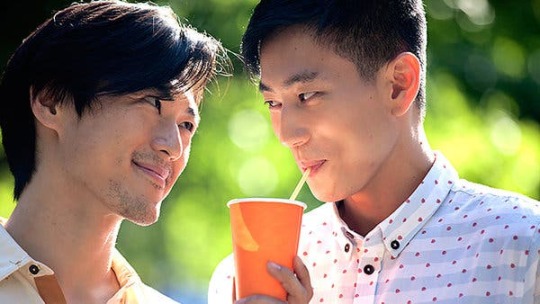
This movie is about a growing friendship between a gay New York fashion stylist (Jake Choi) who rejects his Chinese heritage, is assigned to a rising Beijing patriotic actor (James Chen), who is very heterosexual (mhmm), and over time, their begrudging work relationship turns into friendship and then romance. Ari and Dante...who have complicated relationships with their Mexican heritage, would definitely relate to these two characters -- and would probably enjoy this movie about a relative escapist fantasy on how to navigate being an out queer person of color with seemingly conservative parents.
Saving Face - Amazon Prime
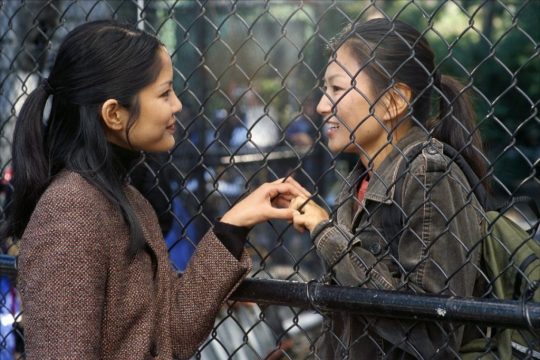
While this movie is about two Chinese American women who love each other, I think Ari and Dante...you two could definitely see your experiences of being a queer person of color living in a conservative religious household and community reflected in this movie. Also, Ari...you disaster gay...you are just like Wilhelmina. I also think you two would appreciate seeing what life is like in an American city and how being queer and a person of color factors into that. This is also a rom com, so I think Ari and Dante, you two deserve to see that happy endings can exist for people like you.
She Ra and the Princesses of Power, Seasons 1- 5 - Netflix

This is again another wlw ship, albeit a tv show this time, and a cartoons kids tv show at that! This is one of the best tv shows I’ve ever watched and I highly recommend this for Ari and Dante. In this reboot of the 1980s series, a magic sword transforms an orphan girl, Adora, into the iconic warrior She-Ra, who unites a rebellion to fight against the evil Galactic Horde, led by Catra, Adora’s childhood friend turned nemesis turned...lover ;). Ari and Dante, ya’ll deserve some spice, some high stakes action, and deep heartfelt emotion akin to your story, and catradora has got it! This show is queer not only in the romances and character relationships, but also in the themes and worldbuilding. Its’ heart is so queer, Ari and Dante, ya’ll’s minds would explode at how creatively and imaginatively queer it is. Go watch until Season 5...I promise you, the buildup and payoff will be worth the binge :)
0 notes
